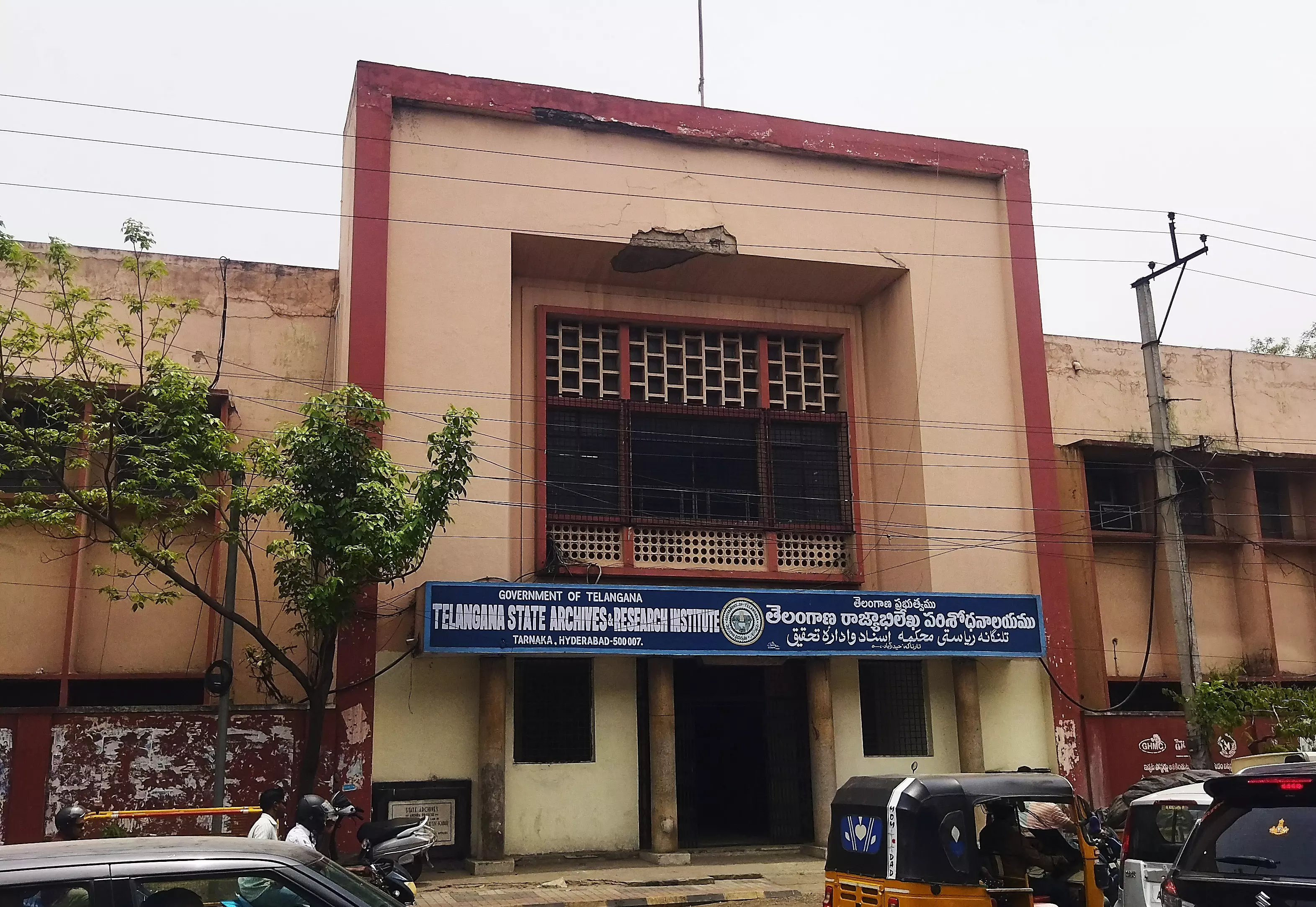Tug-of-war or collective history?

Hyderabad: A decade after bifurcation of the Telugu state, one of the matters recently came to completion was the division of the state’s archives. What was formerly AP State Archives, became Telangana State Archives and Research Institute in 2018. Andhra Pradesh was given a separate office at Manglagiri in Guntur.
The Telangana archive continues to run from the building at Tarnaka constructed in 1965. The prominent art-deco architectural style fails to make an impact on passersby as they are introduced to dust and an unpatched portion of the façade.
The wide stairs, hallmark of both art-deco and Nizamesque architecture, are stacked with old broken chairs. The director’s office on the first floor seems empty as a massive room is only housed by the director’s table and chairs.
Dr Zareena Parveen, the director, is an scholar in archival science and manuscriptology. Holding fort, she has guided many a scholars and researchers delving into the primary records.
“We boast of about 43 million rare and historical records, some even dating back to 1406 AD, ranging from the Bahmani, Qutb Shahi (1581-1687) and Adil Shahi (1569-1686) eras,” she said. The archives also house an international series of Mughal paper manuscripts (1628-1707) and millions of records from the Asaf Jahi period (1724-1948).
“About 80 per cent of these records are in Persian and Urdu. Many records are written in the oldest script of Persian—wherein the lack of nuktas or dots makes it extremely difficult to read the documents. Even Iranians have come and tried reading them but in vain,” said Dr Parveen.
The origin of the state archives department, according to the director, dates back to 1724 AD under the name of ‘Daftar-i-Diwani, Mal-o- Mulki’ consisting of one of the 14 administrative daftars (offices) of the early Asaf Jahi period. It was declared as a regular record office on November 30, 1896 by the Nizam VI Mir Mahboob Ali Khan.
During the period of Mir Osman Ali Khan, Nizam VII, in 1924, the department was raised to the status of directorate. It was renamed the central record office on December 14, 1950, by the then government of Hyderabad and then reorganised and renamed as AP State Archives in 1962, as per the National Archives of India.
In 1992, it was recognized as research institute by Osmania University.
“After the archival bifurcation in 2018, we handed over all the records that belong to Andhra Pradesh. The only records we have are significant composite government orders, from the period between 1956 and 2014, that belong to 10 combined districts. As per the Reorganisation Act, they are kept at Telangana archives for permanent preservation. We have digitised all the governmental documents and can provide a digital copy if someone asks,” said Dr Parveen.
Teports mention a ‘tug-of-war’ situation where both states claim possession of their archival records. Asked about it, Dr Parveen responded with a smile: “The records we have belong to the Deccan. Whatever records that are in Telugu and 12 classical Indian languages, have been shifted to AP. However, how do you divide records that boast of a collective history and shared heritage?”
Having said that, she specifies that she is ‘pakki Telanganite’, taking pride in the movement that led to the formation of the state. The Telangana archives have about 2.6 lakh government orders and about 90 lakh folios from undivided Telugu state.
She listed out the developments and achievements of Telangana archives: translation from Persian into English of about 16,448 records of Jagir administration; conservation of more than one lakh manuscripts in Persian, Urdu and Sanskrit under National Manuscripts Mission (NMM), of which the director is the co-ordinator.
The government had sanctioned `1 crore in 2022 for the digitisation, website development and making a digital repository of the records in the archives. Through this, 15,85,640 pages have been digitised so far.
In collaboration with the Noor Microfilm Internatinal Centre, government of Iran, more than 15 lakh pages in Persian and Urdu have been digitised and about 2, 37,000 pages have been repaired. “The techniques that they use for repair and conservation are unique. They use herbal methods to preserve documents, without any chemicals. They have trees through which a type of gum is derived that helps preserve paper for centuries. We only have the facility to use chemicals like acetone and compactors where we archive all our material. We keep books in red cloths as it has antibacterial properties,” the director said.
When asked about the challenges of managing an institute like this, Dr Parveen said, “As you can see the building needs to be modernised. The maintenance of such important records requires specialised hands,” she said. At present, there are only 35 staff members at the archives.
